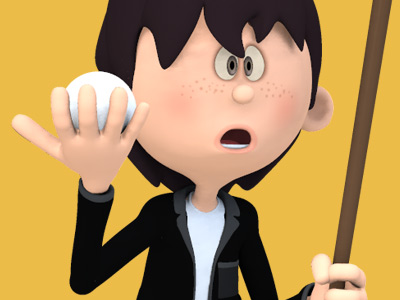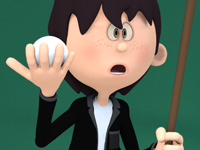Snooker

Gameplay
At the beginning of each frame the balls are set up by the referee. This will be followed by a break-off shot, on which the players take turns. At the break-off, the white cue ball can be placed anywhere inside the D, although it is common for players to start by placing the ball on the line, between the brown ball and either the green or yellow ball.
Players take turns in visiting the table. When one player is at the table, the other cannot play. A break is the number of points scored by a player in one single visit to the table. A player's turn and break end when he fails to pot a ball, when he does something against the rules of the game, which is called a foul, or when a frame has ended.
The ball or balls that can be hit first by the white are called the ball(s) "on" for that particular stroke. The ball(s) "on" differ from shot to shot: a red ball, if potted, must be followed by a colour, a potted colour must be followed by a red, and so on until a break ends; if a red is not potted, any red ball remains the ball "on". Only a ball or balls "on" may be potted legally by a player. If a ball not "on" is potted, this is a foul.
If the cue ball is touching another ball which is on or could be on, the referee shall state that the ball is a "touching ball", whereupon the striker must "play away" from the ball without moving it, and—because the touching ball is deemed to be the object ball—without being required to hit another ball. If the object ball moves, it is considered a "push shot" and a foul shall be called. No penalty is incurred for playing away if (1) the ball is on; (2) the ball could be on and the striker nominates such ball; or (3) the ball could be on and the striker nominates, and first hits, another ball that could be on. If the cue ball is touching another ball which could not be on, it isn't called a touching ball, and the striker must play away from it and hit a legally nominated object ball. Where the cue ball is touching several object balls simultaneously, the referee shall state "Touching ball" for each and every such object ball, and indicate to the player which object balls he is referring to. The rules for each individual touching ball then apply simultaneously.
If a ball is potted when a foul is made, depending on the situation, the potted ball will either stay off the table, or be spotted on its initial spot or it will—along with any and all balls that were moved during the foul shot—be repositioned to where it/they lay before the shot.
The game of snooker generally consists of two phases. The first phase is the situation in which there are still red balls on the table. In the first phase, at the beginning of a player's turn, the balls "on" are all remaining red balls. The player must therefore attempt to first hit and pot one or more red balls. For every red ball potted, the player will receive 1 point. When a red has been potted, it will stay off the table and the player can continue the break. If no red has been potted or a foul has been made, the other player will come into play.
In case one or more red balls have been potted, the player can continue the break. This time one of the six colours (yellow, green, brown, blue, pink and black) is the ball "on". Only one of these can be the ball "on" and the rules of the game state that a player must nominate the desired colour to the referee, although it is usually clear which ball the striker is playing and it is not necessary to nominate.
When the nominated colour is potted, the player will be awarded the correct number of points (yellow, 2; green, 3; brown, 4; blue, 5; pink, 6; black, 7). The colour is then taken out of the pocket by the referee and placed on its original spot. If that spot is covered by another ball, the ball is placed on the highest available spot. If there is no available spot, it is placed as close to its own spot as possible in a direct line between that spot and the top cushion, without touching another ball. If there is no room this side of the spot, it will be placed as close to the spot as possible in a straight line towards the bottom cushion, without touching another ball.
Because only one of the colours is the ball "on", it is a foul to first hit multiple colours at the same time, or pot more than one colour (unless a free ball has been awarded).
After the nominated colour is potted, the red balls are "on" again.
If a player fails to pot a ball "on", it being a red or nominated colour, the other player will come into play and the balls "on" are always the reds, as long as there are still reds on the table.
The alternation between red balls and colours ends when all reds have been potted and a colour is potted after the last red, or a failed attempt to do so is made. All six colours have then to be potted in ascending order of their points value (yellow, green, brown, blue, pink, black). Each becomes the ball "on" in that order. During this phase, when potted, the colours stay down and are not replaced on the table, unless a foul is made when potting the colour, in which case the colour is respotted.
When the colours have been potted, the frame is over and the player who has scored most points has won it.
SPORTS

RESOURCES
This article uses material from the Wikipedia articles "Snooker" and "Rules of snooker", which is released under the Creative Commons Attribution-Share-Alike License 3.0.
© Stories Preschool. All Rights Reserved.








